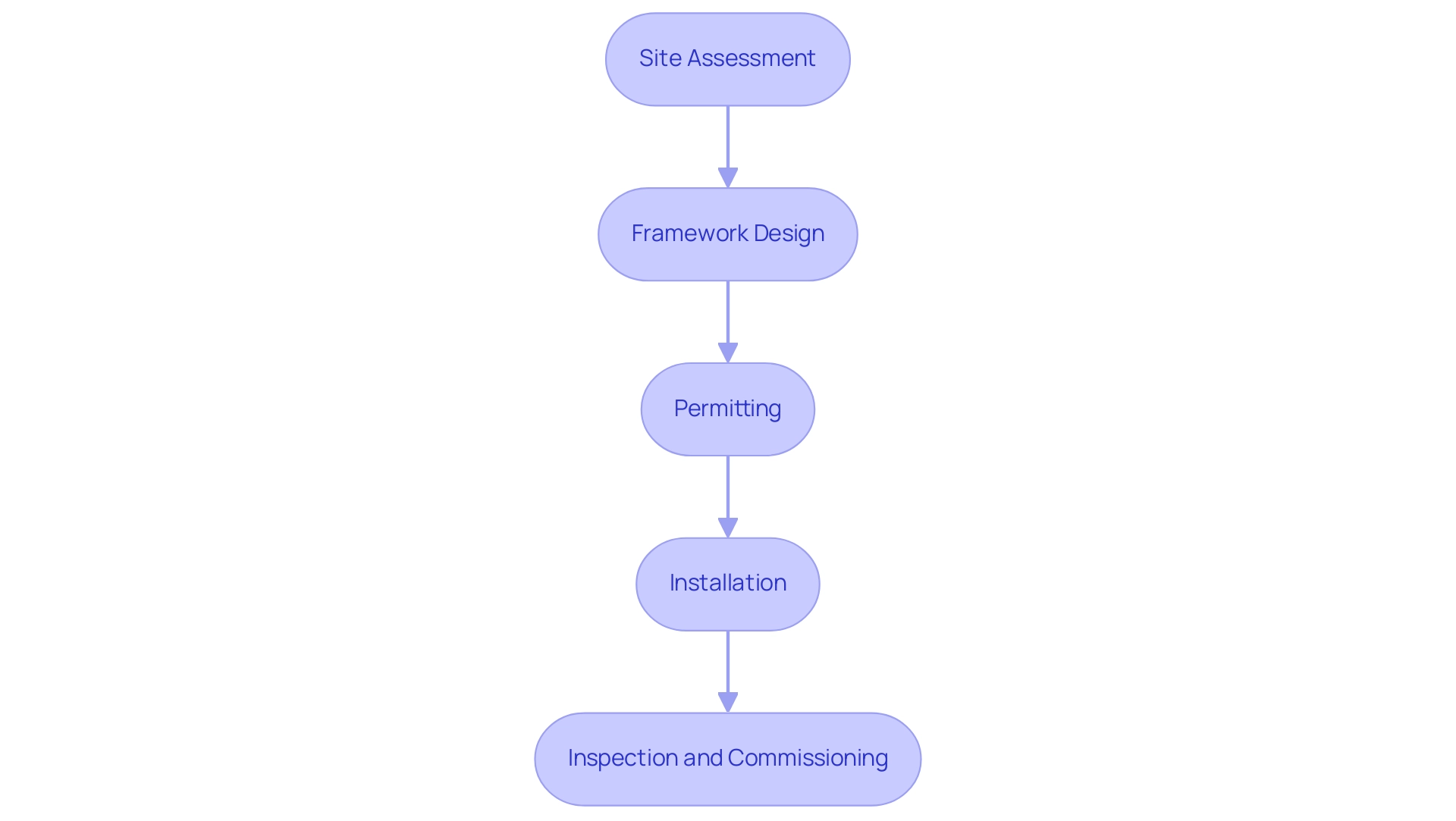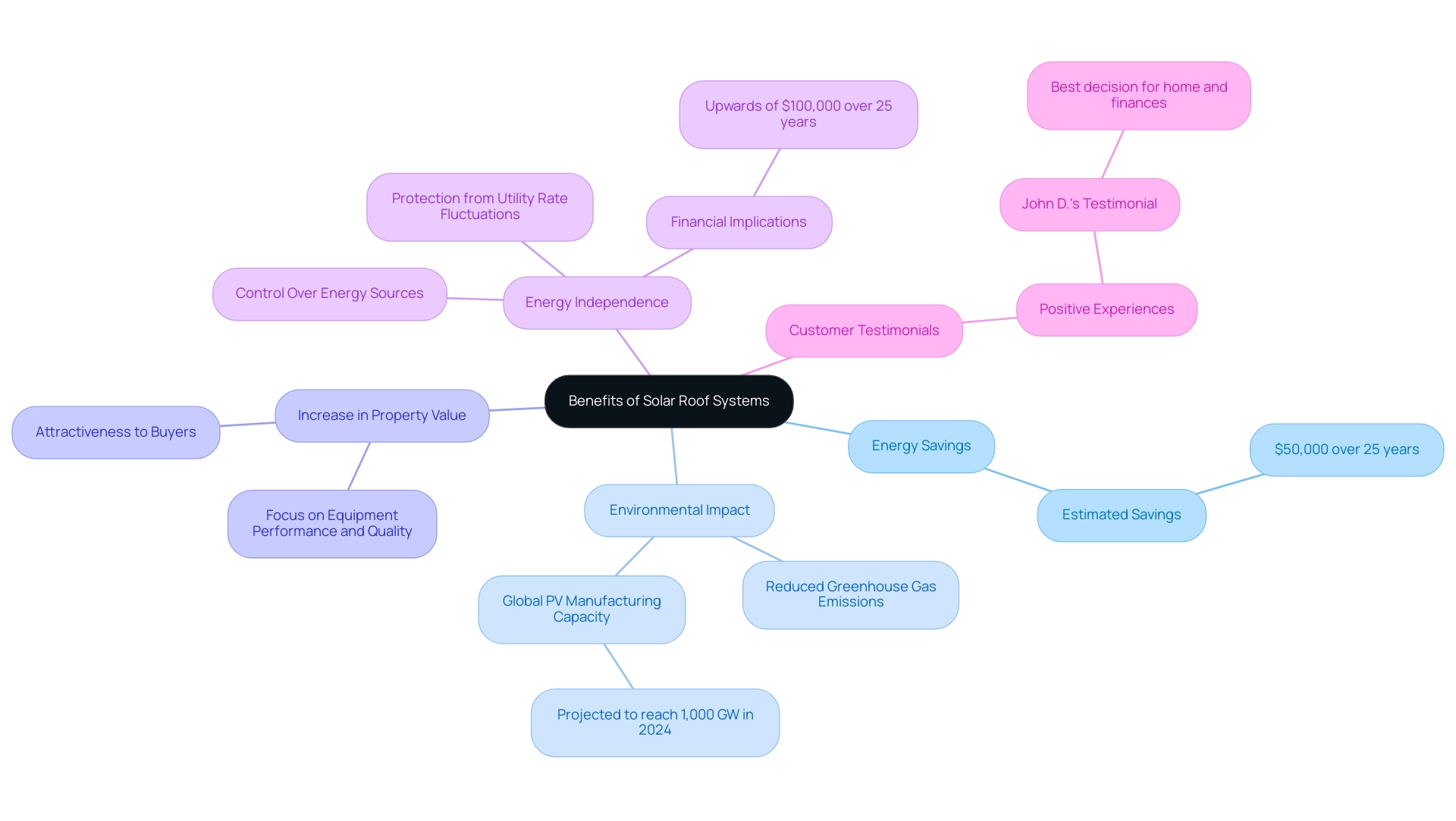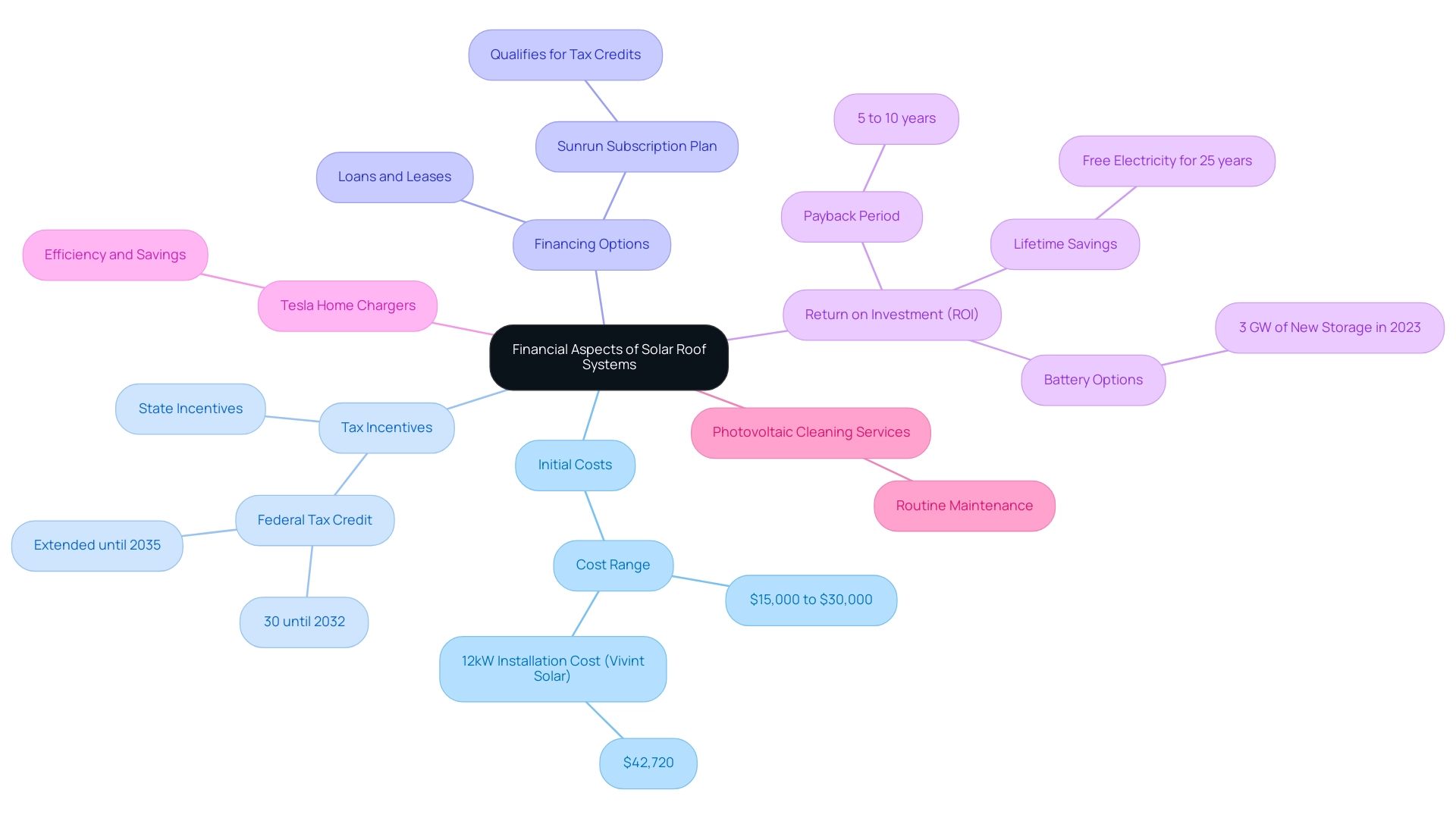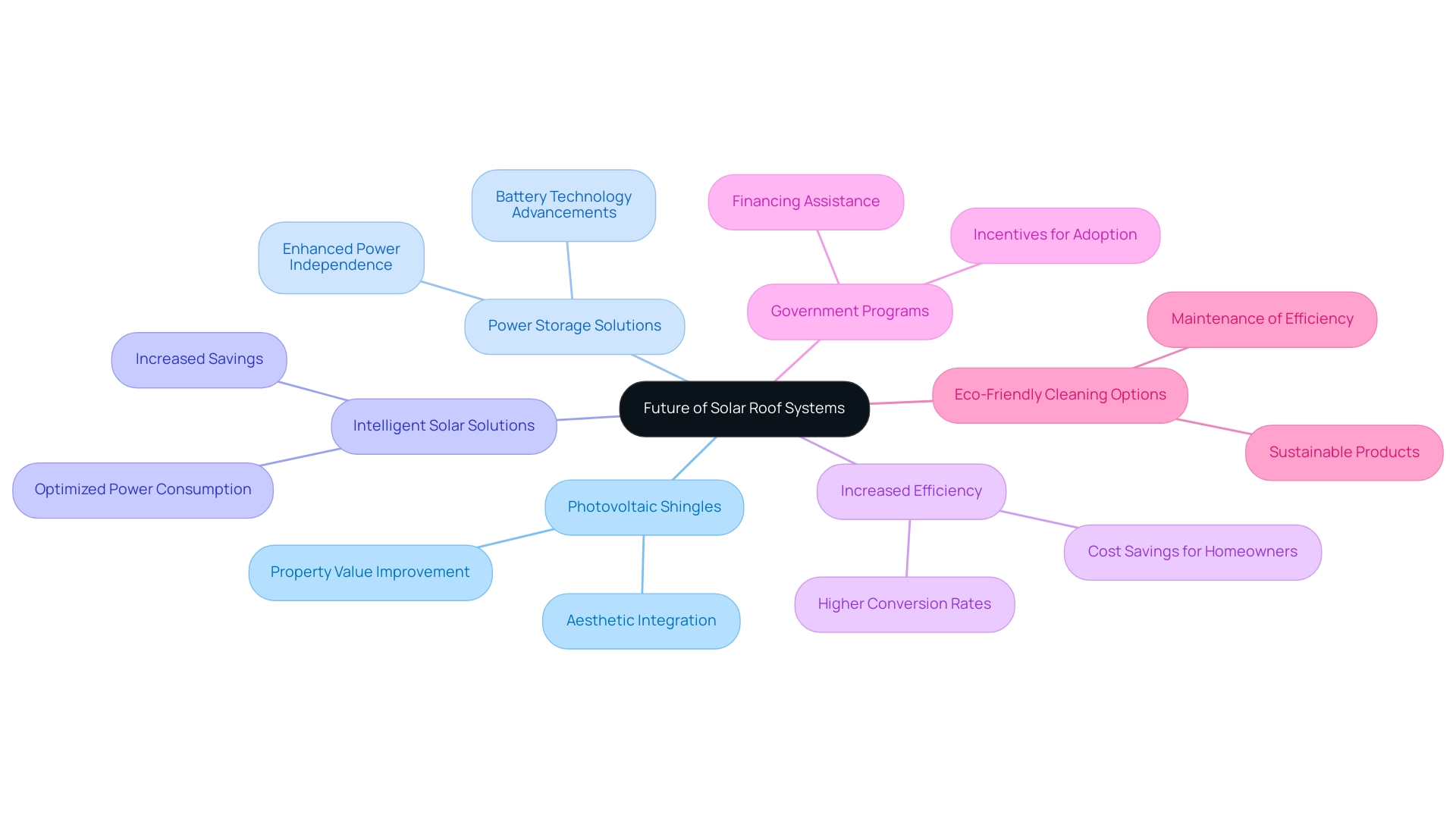Introduction
As the world increasingly shifts towards sustainable energy, solar roof systems are emerging as a practical and eco-friendly choice for homeowners. These systems not only promise significant savings on electricity bills but also contribute to a greener planet by reducing reliance on fossil fuels.
With a wealth of information available about the components, installation processes, and maintenance tips, navigating the transition to solar energy can feel much more manageable.
From understanding the financial aspects, including costs and incentives, to exploring innovative trends like solar shingles and energy storage solutions, homeowners can empower themselves with knowledge that enhances their energy independence.
This article delves into the essential elements of solar roof systems, offering insights and guidance for those ready to embrace a sustainable future.
Introduction to Solar Roof Systems: Components and Installation Process
Roof installations comprise multiple essential elements that collaborate to effectively capture sunlight energy using a solar roof system. These consist of photovoltaic modules, inverters, mounting structures, and monitoring devices. Here’s how the installation process typically unfolds:
- Site Assessment: A qualified professional will evaluate your roof’s condition, orientation, and shading to identify the most suitable energy solution for your home.
- Framework Design: According to the preliminary evaluation, a tailored layout for your energy setup is developed, outlining the kind and quantity of photovoltaic units necessary to fulfill your power requirements.
- Permitting: Before any installation can take place, securing the necessary permits from local authorities is crucial. This step ensures that your installation complies with all regulations.
- Installation: During this phase, the installation team carefully mounts the photovoltaic panels onto your roof and connects them to the inverter and your home’s electrical system.
- Inspection and Commissioning: Once the installation is complete, the setup undergoes a thorough inspection to confirm everything is functioning correctly. Following this, a final commissioning process activates the system, allowing you to start generating renewable energy.
Understanding the components and installation steps of a solar roof system can empower you, making the transition to renewable energy feel more approachable. With installations projected to remain steady at around 40-45 GW annually over the next five years, now is an exciting time to consider investing in solar roof systems and other renewable energy technologies. This growth is backed by ambitious government targets, policy support, and increasing competitiveness.
As noted by Piotr Bojek, ‘Investment in PV is expected to grow further in the coming years thanks to ambitious government targets, policy support, and increasing competitiveness.’ Additionally, the private sector is significantly involved in photovoltaic deployment, with companies investing in solar roof systems and corporate power purchase agreements. This dynamic not only enhances technology but also opens up opportunities, such as the renewable energy sector emerging as a promising field for veterans, with 8% of renewable energy employees being veterans compared to 5% in the overall workforce.
Best Energy Storage Battery Choices for Efficient Energy Storage
To maximize the benefits of your renewable energy installation, it’s essential to consider the best energy storage battery options available. These batteries store surplus power generated during the day for use at night or during overcast times. Popular choices include lithium-ion batteries for their efficiency and longevity, along with lead-acid batteries for cost-effectiveness.
Each choice has its benefits, so assess your power requirements and budget when choosing a battery.
Maintenance Tips for Photovoltaic Modules
Regular upkeep is essential for maintaining the effectiveness and lifespan of your photovoltaic setup. Here are some practical tips:
- Routine Inspections: Check your panels periodically for dirt, debris, or damage.
- Cleaning: Use a gentle cleaning solution and soft brush to remove buildup, especially after storms.
- Monitoring Performance: Keep an eye on your setup’s performance through monitoring software to identify any drops in efficiency promptly.
By integrating these maintenance practices and considering the right battery options, homeowners can enhance their renewable power experience and contribute to a sustainable future.
The Benefits of Solar Roof Systems: Energy Savings and Environmental Impact
Investing in a solar roof system brings a host of benefits that can uplift both your wallet and the planet, especially for Long Beach renters looking to go green:
- Energy Savings: Homeowners have the potential to drastically cut their electricity bills by generating their own power. In fact, many achieve net-zero power costs, resulting in estimated savings of around $50,000 over 25 years, depending on location and electricity prices. This aligns with insights from a case study titled “Estimated Savings from Solar Panels,” which shows that average U.S. homeowners can expect substantial long-term savings.
- Environmental Impact: Shifting to renewable power decreases dependence on fossil fuels, resulting in reduced greenhouse gas emissions and a considerably smaller carbon footprint. With the worldwide production capability of photovoltaic systems expected to approach almost 1,000 GW in 2024, the transition toward renewable power is more significant than ever. This expansion not only signifies a strong market for renewable energy but also suggests greater availability and potentially reduced expenses for homeowners seeking to invest in energy solutions.
- Increase in Property Value: Homes fitted with photovoltaic technology often experience a rise in property value, rendering them more attractive to prospective buyers. This trend is increasingly recognized in real estate, as buyers prioritize energy-efficient homes. Installers, like Powercore Electric, focus on equipment performance, quality, brand reputation, and product warranty to ensure homeowners receive reliable and high-quality systems that enhance property value.
- Energy Independence: Utilizing sunlight energy provides homeowners increased control over their energy sources, protecting them from the fluctuations of utility rates. As Emily Walker, a pleased client, aptly states, “We’re talking upwards of $100,000 over 25 years in some cases” when considering the financial implications of investing in renewable energy.
- Customer Testimonials: Many of our customers have shared their positive experiences with Powercore Electric. For instance, John D. states, “Transitioning to renewable energy was the best decision I made for my home and my finances. Powercore made the process easy and straightforward!”
These benefits not only encourage financial savings but also create opportunities for a more sustainable and eco-friendly lifestyle, making a solar roof system a wise choice for environmentally-conscious homeowners. With Powercore Electric’s local expertise, unmatched quality craftsmanship, and a customer-first approach, you can trust that your journey to renewable energy will be seamless and rewarding. Contact us today for a free, personalized estimate and take the first step towards a greener future!
Financial Aspects of Solar Roof Systems: Costs, Incentives, and ROI
When you’re thinking about installing a solar roof system, there are several financial aspects worth considering:
- Initial Costs: The average expense for photovoltaic installations can vary significantly, typically ranging from $15,000 to $30,000 before any incentives take effect. For example, if you’re looking at a 12kW installation with companies like Vivint Solar, you’re looking at an estimated cost of around $42,720. However, don’t let these numbers deter you—there are plenty of options available to make this investment more manageable.
- Tax Incentives: Thanks to recent changes brought about by the Inflation Reduction Act, homeowners can benefit from federal tax credits, which have increased to 30% until 2032. This extension until 2035 opens up more opportunities for you to save on your initial investment, alongside various state incentives that can further lower your costs. It’s worth checking what your state offers!
- Financing Options: There are several financing plans available that make adopting renewable energy more accessible. Choices such as loans and leases enable you to distribute expenses over time, lessening the initial load. Homeowners renting a solar roof system through the Sunrun Subscription Plan can also qualify for these tax credits, simplifying your shift to renewable energy. As Sunrun states, “From paperwork to panel installation to maintenance, we take care of the rest.”
- Return on Investment (ROI): Many homeowners can expect a payback period of about 5 to 10 years. Following this duration, the savings on electricity can be considerable with a solar roof system, as you’ll benefit from free electricity for the lifetime of your setup, which usually lasts for approximately 25 years. Furthermore, with 3 GW of new storage solutions implemented alongside photovoltaic energy in 2023, the incorporation of battery options is becoming more crucial, further improving the economic feasibility of such installations.
- Tesla Home Chargers: If you’re contemplating an electric vehicle, combining your power system with a Tesla home charger can enhance your efficiency and savings. Charging your vehicle with sunlight energy can significantly reduce your transportation costs.
- Photovoltaic Cleaning Services: To uphold the effectiveness of your energy collectors, routine cleaning is crucial. Many services are available that specialize in panel maintenance, ensuring that your investment continues to perform at its best.
These insights not only clarify the financial aspect of renewable energy investments but also enable you to make informed choices that can result in a more sustainable future. Additionally, comprehending the market dynamics, as indicated by the ‘Solar PV Growth Forecast,’ will assist you in recognizing the long-term advantages of investing in photovoltaic technology. With government programs backing these initiatives, cleaning services ensuring your systems stay efficient, and innovative battery options, it’s a great time to consider renewable energy for your home!
Maintaining Your Solar Roof: Tips for Optimal Performance
To keep your rooftop energy system running smoothly and to maximize its performance, here are some essential maintenance tips:
- Regular Cleaning: Dust, debris, and leaves can obstruct sunlight from reaching your solar units, significantly impacting their efficiency. Aim to clean them a few times a year, especially after storms or heavy winds. Remember, when temperatures exceed 77°F (25°C), your solar panels may lose efficiency by about 1% for each degree above that. Regular cleaning not only improves power generation but also aids your objective of a more sustainable home.
- Monitoring System Performance: Implement monitoring tools to keep an eye on your power production. If you notice a significant drop in output, it might be time to investigate—this could indicate dust buildup or other issues that need attention. As one expert noted, ‘Did you observe a significant drop in power production? This issue can be due to a variety of factors, with the most common being dust and debris buildup. However, it can also be caused by malfunctioning components. The most effective method to ascertain this is via the process of elimination, beginning with cleaning the surface. With over two million U.S. households harnessing solar power as of 2019, performance monitoring has never been more crucial.
- Scheduled Inspections: Plan for professional inspections every few years. Experts can identify potential issues, such as electrical faults or roof damage, before they escalate, ensuring your system remains in top condition and continues to contribute to your power requirements.
- Check for Shading: Regularly assess your surroundings to ensure trees or nearby buildings aren’t casting shadows on your panels. Even partial shading can substantially hinder their effectiveness and overall energy production.
- Support Content Creators: By contributing financially to content creators in the renewable energy sector, you help promote valuable information and innovations that can enhance your experience, fostering a community of shared knowledge.
- Sustainable Practices: Stay informed about the latest advancements in photovoltaic technology, like companies creating modules for disassembly and recycling. These innovations not only promote a circular economy but also reduce costs for producers and lessen environmental impact. By adopting these best practices, you can extend the lifespan of your solar roof system—modern panels typically last between 20 to 30 years, maintaining about 80% productivity after 25 years. Data indicates that the median loss rate for photovoltaic system performance is 0.75% per year, with 90% of systems encountering less than a 2% loss each year. Regular maintenance and embracing potential recycling initiatives will help you enjoy significant energy savings while contributing to a greener planet.
The Future of Solar Roof Systems: Innovations and Trends
The renewable energy sector is on an exciting trajectory, filled with innovations such as the solar roof system that can greatly benefit eco-conscious homeowners. While it’s important to note that this year, installations are expected to decline slightly by 2%, driven mostly by a 26% decline in the residential segment, several key trends are emerging that you should keep an eye on:
-
Photovoltaic shingles are integrated into a solar roof system, blending traditional roofing with photovoltaic technology to provide a stylish and visually appealing solution that doesn’t compromise on aesthetics.
They can be an excellent choice for homeowners seeking to improve their property’s appearance while utilizing a solar roof system to harness renewable energy.
-
Power Storage Solutions: Thanks to advancements in battery technology, homeowners can now store surplus sunlight power for use during cloudy days or at night, enhancing power independence and reliability. Investigating the top battery options can assist you in choosing a solution that aligns with your power requirements.
-
Intelligent Solar Solutions: The incorporation of advanced home technologies enables residents to optimize their power consumption, maximizing the benefits of their photovoltaic output while reducing waste. This signifies you can optimize your energy system output and benefit from increased savings on your utility expenses.
-
Increased Efficiency: Ongoing research is pushing the boundaries of panel efficiency, enabling them to convert a greater percentage of sunlight into electricity. Homeowners can enjoy enhanced performance and savings, especially as the market continues to evolve.
-
Government Programs: Various government initiatives are available to assist homeowners in financing solar roof system, making it more accessible to invest in this technology. These programs can offer significant savings and incentives for adopting energy solutions from the sun.
-
Eco-Friendly Cleaning Options: To sustain the efficiency and longevity of your energy collectors, consider using eco-friendly cleaning products. These options assist in maintaining your panels clean without damaging the environment, ensuring optimal performance.
With projections indicating a rise to 574 GW of additions in 2024—29% higher than the previous year—it’s evident that the energy landscape is thriving and evolving. Furthermore, China’s anticipated increase of 28% more renewable energy capacity in 2024, potentially achieving a total installed capacity of 334 GW, underscores the competitive global market. Staying ahead of these trends not only helps you make informed decisions, it also ensures your investments are future-proof.
Don’t forget to consider Tesla home chargers as part of your solar energy innovations, enhancing your home’s energy efficiency!
Conclusion
Investing in solar roof systems represents a significant step toward a sustainable and financially savvy future. Homeowners can enjoy substantial savings on energy bills, with many achieving net-zero energy costs over time. The environmental benefits are equally compelling, as solar energy reduces reliance on fossil fuels and helps lower greenhouse gas emissions, contributing to a healthier planet.
Understanding the components and installation process of solar systems can empower homeowners to make informed decisions. From site assessments to selecting the right solar batteries and maintenance practices, being proactive about these aspects ensures optimal performance and longevity of the system. Additionally, with various financial incentives and financing options available, the initial investment becomes much more manageable, paving the way for a strong return on investment.
As the solar industry continues to innovate, trends such as solar shingles, energy storage solutions, and smart solar systems are making it easier and more appealing for homeowners to adopt solar energy. Embracing these advancements not only enhances energy independence but also positions homeowners at the forefront of a growing and dynamic market.
In conclusion, the journey toward a solar-powered home is filled with opportunities for savings, environmental impact, and technological advancements. By taking the first step today, homeowners can contribute to a sustainable future while enjoying the myriad benefits that come with harnessing the power of the sun.







